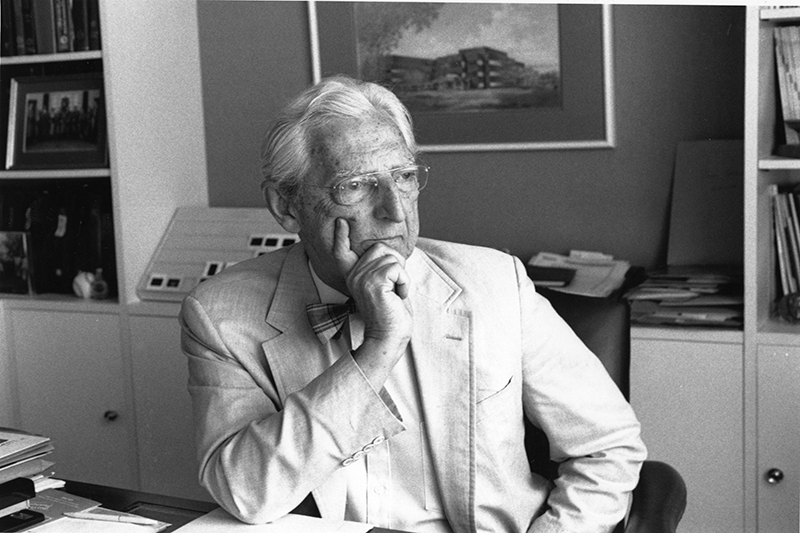Father of IVF in the United States dies at 104

Howard W. Jones Jr., MD, co-founder of the EVMS Jones Institute for Reproductive Medicine and Professor Emeritus of Obstetrics and Gynecology at EVMS, died July 31, 2015, at the age of 104. Along with his late wife, endocrinologist Georgeanna Jones, MD, Dr. Howard Jones is responsible for the first in vitro fertilization (IVF) baby born in the United States.
Dr. Jones and his wife came to EVMS in 1978 from Johns Hopkins University Medical Center to co-chair the Norfolk-based medical school’s Obstetrics and Gynecology department. They relocated from Baltimore after Georgeanna reached what was then Johns Hopkins’ mandatory retirement age of 65. (The school had allowed Dr. Howard Jones to stay on an extra two years because he and his wife shared an office.)
In 1979, the couple opened America’s first in vitro fertilization clinic at EVMS. In spring 1981, their work resulted in the clinic’s first pregnancy, which culminated in the December 1981 birth of the nation’s first IVF baby, Elizabeth Jordan Carr. Dr. Jones was 70 at the time.
“The IVF success was an incredible accomplishment, not just for him personally but for our institution and for the profession of medicine,” says Richard Homan, MD, President and Provost of EVMS and Dean of the School of Medicine.
But there was much more to Dr. Jones than his signature achievement, Dr. Homan says.
“There are few people who inspire you when you first meet them. Dr. Jones was one of those individuals. He exuded an enthusiasm and a curiosity, and he was intellectually keen and extraordinarily bright, yet humble and human and approachable. He was the consummate scholar, academician and physician and a role model for all of us to emulate.”
As a medical student in the mid 1980s, Alfred Abuhamad, MD, was inspired by Dr. Jones and his work. Dr. Abuhamad eventually became Chair of Obstetrics and Gynecology at EVMS and the Mason C. Andrews Chair in Obstetrics and Gynecology. And Dr. Jones became his colleague and prized mentor.
“EVMS is incredibly fortunate to have had Dr. Jones here,” Dr. Abuhamad says. “His accomplishments in reproductive medicine and in vitro fertilization were incredible and amazing. He and Dr. Georgeanna revolutionized how we care for women with infertility problems. Everywhere you look around the world you can see Howard and Georgeanna Jones in the fellows they trained, in the discoveries they made and in the countless patients they impacted.”
Born in Baltimore in 1910, Dr. Jones was the son of a physician and was delivered by the obstetrician-father of Georgeanna Seegar, who would become his wife in 1940. He received his MD from Johns Hopkins University in 1935 and worked in gynecology at Johns Hopkins Hospital.
After completing a residency in surgery, he served as a surgeon during World War II in the United States Medical Corps. When the war ended, he completed a second residency in gynecology and eventually became the go-to surgeon at Johns Hopkins for genital abnormalities and reconstructions.
In 1948, Dr. Jones and his wife became part-time faculty members at Johns Hopkins while operating a private practice. In 1960, they left private practice to teach medicine full-time. In 1965 at John Hopkins, they met and worked with English scientist Robert Edwards, MD, whose research led to the 1978 birth in England of Louise Brown, the world’s first baby conceived through in-vitro fertilization.
The Joneses arrived in Norfolk the day of Louise Brown’s birth. Asked by a Virginian-Pilot reporter if the same thing could be done in the U.S., Dr. Howard Jones replied it could – and added, flippantly – “all we need is money.” To their surprise, a former patient of Dr. Georgeanna Jones read the story and called with an offer to help. The resulting donation was the seed money that launched the Joneses’ work.
In 1984, Dr. Jones saw the need for an ethics panel related to reproductive technology and helped establish the ethics committee of the American Fertility Society, now known as the American Society for Reproductive Medicine.
He held honorary degrees from the University of Cordoba, Old Dominion University, Amherst College, University of Madrid and EVMS and received the Medal of the College of France and the Distinguished Service Award of the American College of Obstetrics and Gynecology. He was made an honorary member of more than 20 foreign scientific societies, including the Fellowship ad eundem of the Royal College of Obstetricians and Gynecologists.
Dr. Jones also held the rank of Professor Emeritus at Johns Hopkins University School of Medicine where between 1967 and 1976, he served as Professor of Gynecology and Obstetrics, Acting Chairman of the OB/GYN Department, and Secretary General of the university’s Program for International Education.
He is the author of 12 books, the most recent of which, In Vitro Fertilization Comes to America: Memoir of a Medical Breakthrough, was published in December 2014. Until he was hospitalized in July, Dr. Jones still kept regular office hours in the building that bears his name. He was a regular at scientific conferences and kept up with and contributed to the latest literature. He officially retired in 1997 after Dr. Georgeanna Jones developed Alzheimer’s disease. She died in 2005.
The success Dr. Jones achieved in Norfolk almost never came to pass. As their careers were coming to an end at Johns Hopkins, the couple consulted with their three children about the move to Norfolk. They unanimously agreed that their parents should retire and remain in Baltimore.
In a 1996 interview Dr. Jones said, “I think our lives would have withered on the vine if we hadn’t come here.”